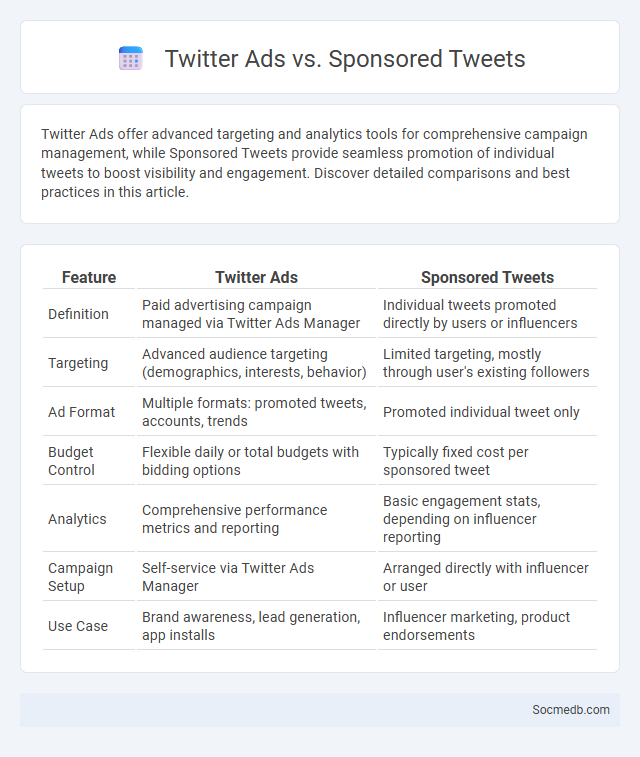
Photo illustration: Twitter Ads vs Sponsored Tweets
Twitter Ads offer advanced targeting and analytics tools for comprehensive campaign management, while Sponsored Tweets provide seamless promotion of individual tweets to boost visibility and engagement. Discover detailed comparisons and best practices in this article.
Table of Comparison
| Feature | Twitter Ads | Sponsored Tweets |
|---|---|---|
| Definition | Paid advertising campaign managed via Twitter Ads Manager | Individual tweets promoted directly by users or influencers |
| Targeting | Advanced audience targeting (demographics, interests, behavior) | Limited targeting, mostly through user's existing followers |
| Ad Format | Multiple formats: promoted tweets, accounts, trends | Promoted individual tweet only |
| Budget Control | Flexible daily or total budgets with bidding options | Typically fixed cost per sponsored tweet |
| Analytics | Comprehensive performance metrics and reporting | Basic engagement stats, depending on influencer reporting |
| Campaign Setup | Self-service via Twitter Ads Manager | Arranged directly with influencer or user |
| Use Case | Brand awareness, lead generation, app installs | Influencer marketing, product endorsements |
Introduction to Twitter Advertising Options
Twitter advertising options include Promoted Tweets, Promoted Accounts, and Promoted Trends, each designed to increase your brand's visibility and engagement on the platform. Leveraging Twitter's targeted ads can help you reach specific demographics based on interests, location, and behavior, optimizing campaign performance. Understanding these options allows you to tailor your marketing strategy effectively to boost conversions and drive traffic.
Understanding Twitter Ads
Twitter Ads leverage targeted algorithms to connect brands with specific audiences based on demographics, interests, and user behavior, maximizing campaign reach and engagement. Utilizing formats such as promoted tweets, trends, and accounts, advertisers can amplify content visibility and drive conversions effectively. Real-time analytics and A/B testing capabilities enable precise optimization of ad performance and budget allocation on the platform.
What Are Sponsored Tweets?
Sponsored tweets are paid advertisements appearing seamlessly in your Twitter feed, designed to promote brands, products, or services directly to targeted audiences. These tweets utilize advanced targeting options such as demographics, interests, and behavior to maximize engagement and conversion rates. Your business can leverage sponsored tweets to increase visibility, drive traffic, and boost sales efficiently on the platform.
Exploring Twitter Ad Campaigns
Twitter ad campaigns offer powerful tools to boost Your brand's visibility and engagement by targeting specific demographics and interests with precision. Utilizing promoted tweets, trends, and accounts enables businesses to reach a highly active user base, increasing click-through rates and conversions. Optimizing campaign settings based on analytics ensures maximum ROI and improved audience interaction on the platform.
Key Differences: Twitter Ads vs Sponsored Tweets
Twitter Ads offer comprehensive campaign options with targeting based on demographics, interests, and behaviors, supporting multiple ad formats such as promoted tweets, accounts, and trends. Sponsored Tweets specifically highlight individual tweets and aim to boost engagement by appearing directly in users' timelines, making them ideal for focused content promotion. Understanding these differences helps you optimize your social media strategy for brand awareness or direct audience interaction.
Targeting Capabilities Comparison
Social media platforms like Facebook, Instagram, LinkedIn, and Twitter offer distinct targeting capabilities tailored to different marketing objectives and audience demographics. Facebook provides advanced targeting options including lookalike audiences and detailed user interests, while LinkedIn excels in B2B targeting with filters such as job title, industry, and company size. Instagram integrates with Facebook's ad system, enabling precise demographic and behavioral targeting, whereas Twitter focuses on keyword targeting and follower lookalikes for real-time engagement campaigns.
Cost and Budgeting Considerations
Social media advertising costs vary widely based on platform, audience targeting, and campaign objectives, with average CPC (cost per click) ranging from $0.50 to $3.50 on platforms like Facebook and Instagram. Your budgeting should account for factors such as ad format, bid strategy, and daily spend limits to maximize return on investment while minimizing unnecessary expenditure. Effective cost management requires continuous monitoring and adjusting campaign parameters to ensure optimized performance and avoid budget overruns.
Performance Metrics & ROI
Tracking social media performance metrics such as engagement rate, click-through rate (CTR), conversion rate, and follower growth is essential for evaluating campaign effectiveness. Calculating the return on investment (ROI) involves comparing these metrics against the costs of content creation, advertising spend, and management tools. Your data-driven insights enable optimized strategies that maximize social media ROI and drive measurable business growth.
Choosing the Best Option for Your Goals
Choosing the best social media platform for your goals requires analyzing your target audience's demographics, preferred content types, and engagement patterns. Platforms like Instagram offer strong visual storytelling for brand awareness, while LinkedIn excels in B2B networking and professional growth. Tailoring your strategy to the platform aligned with your objectives maximizes reach, engagement, and return on investment for your campaigns.
Conclusion: Which Twitter Promotion Method Wins?
Twitter's organic engagement strategies offer authentic interactions, while paid promotions provide targeted reach and measurable results. Your choice depends on budget constraints, audience targeting precision, and campaign goals, with paid ads excelling in speed and scale. Combining both methods optimizes visibility and drives comprehensive Twitter success.
 socmedb.com
socmedb.com